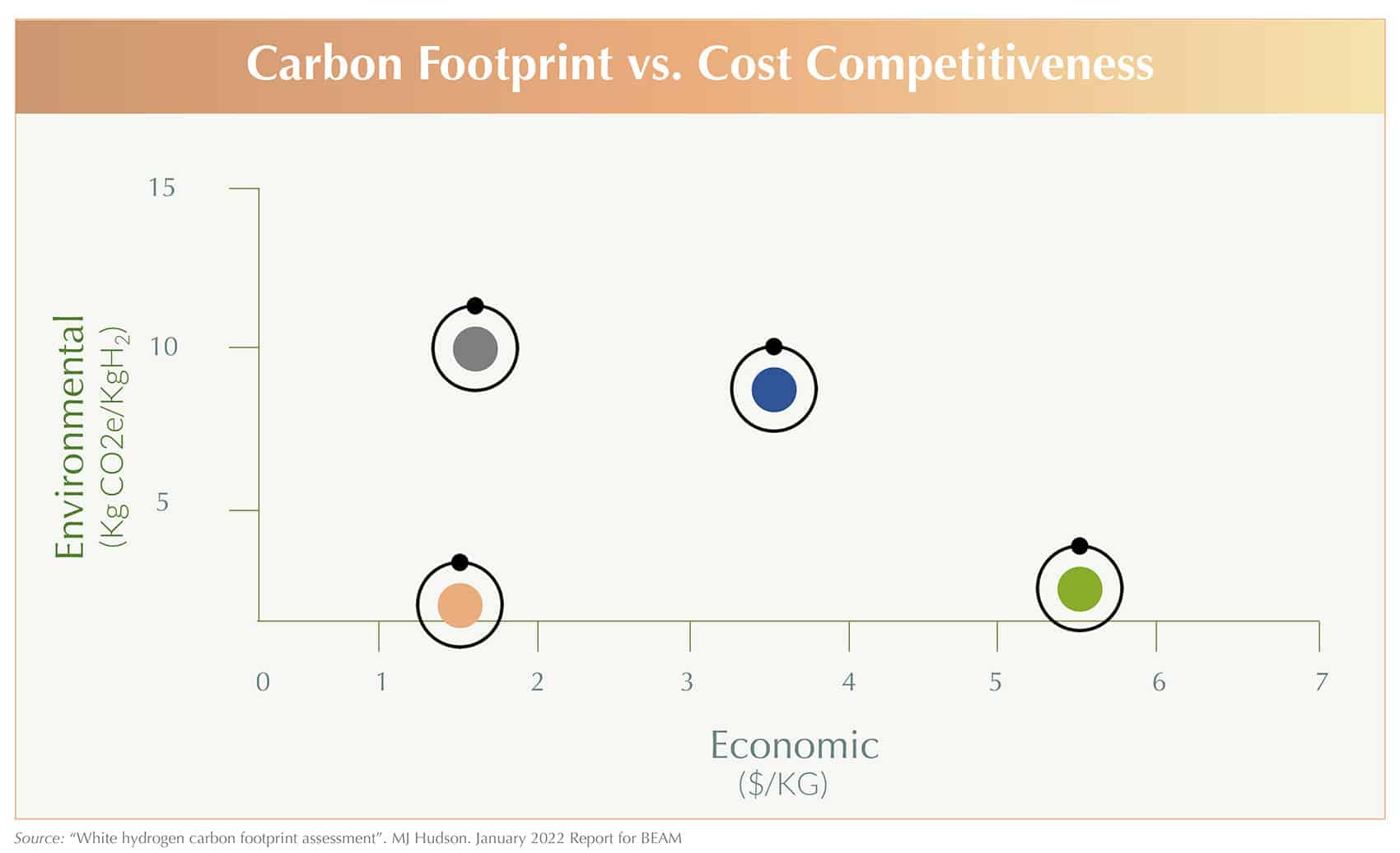Hydrogen
Spectrum
Hydrogen production uses a variety of methods. Hydrogen classification
by color and cost depends on the production process
Hydrogen
Spectrum
Hydrogen production uses a variety of methods. Hydrogen classification by color and cost depends on the production process

Environmental
vs. Economic
Aspect
|
Grey/Brown Hydrogen
|
|
Blue Hydrogen
|
|
Green Hydrogen
|
|
Natural Hydrogen
|
*CCUS: Handled via carbon capture technologies

Hydrogen
Past
Hydrogen
Present
 Yes, my friends, I believe that water will one day be employed as fuel, that hydrogen and oxygen which constitute it, used singly or together, will furnish an inexhaustible source of heat and light, of an intensity of which coal is not capable
Yes, my friends, I believe that water will one day be employed as fuel, that hydrogen and oxygen which constitute it, used singly or together, will furnish an inexhaustible source of heat and light, of an intensity of which coal is not capable 
Jules Verne – The Mysterious Island, 1865

Hydrogen is almost everywhere. It makes up 75% of all normal matter either in the form of water or hydrocarbons. As a molecule on its own, hydrogen is light, odorless, colorless, tasteless, non-toxic and highly combustible
To achieve Net Zero carbon emissions by 2050, great hopes are pinned on hydrogen meeting at least 13% of the total global energy demand. This is because it has two times more energy per unit mass than natural gas; it does not emit CO₂ or general greenhouse gases emissions when burnt; it can be used and stored without indirect emissions; and it can perform as an energy carrier
Hydrogen is a large and fast-growing market, worth roughly US$150 billion globally. According to the International Energy Agency’s Net Zero Emissions Scenario, it is predicted to expand 122% from less than 90 million tonnes per annum in 2020 to more than 200 million tonnes by 2030
For this to happen, existing hydrogen production needs to be cleaner and the exploration and production of natural hydrogen (which exists in a wide range of rock formations and geological regions) needs to take center stage. And this comes with an added bonus: where geological hydrogen flows, helium is often found
Hydrogen
Future
Hydrogen’s potential makes the ubiquitous gas an investment opportunity with US$240 billion to be invested in hydrogen projects by 2030, according to Hydrogen Insights
Hydrogen is instrumental in difficult-to decarbonize sectors, such as steelmaking, residential and commercial heating, long distance road freight, and shipping. Hydrogen-based products in particular, such as methanol and ammonia, are key to decarbonizing whole industries

Methanol is a 37Bn$ market. Primarily used for chemical and energy industries, renewable methanol is easy to use as transportation fuel, especially for heavy mobility, starting with the maritime sector.

Hydrogen’s high energy to mass ratio and low storage/transportation losses make it an ideal replacement for fossil fuels in some sectors. Click to learn more
Energy Transition is not simply about lowering emissions, it is about guaranteeing a stable future
History of
Hydrogen
 |
Grey/Brown Hydrogen
|
 |
Blue Hydrogen
|
 |
Green Hydrogen
|
 |
Natural Hydrogen
|
*CCUS: Handled via carbon capture technologies

Hydrogen
Present
 Yes, my friends, I believe that water will one day be employed as fuel, that hydrogen and oxygen which constitute it, used singly or together, will furnish an inexhaustible source of heat and light, of an intensity of which coal is not capable
Yes, my friends, I believe that water will one day be employed as fuel, that hydrogen and oxygen which constitute it, used singly or together, will furnish an inexhaustible source of heat and light, of an intensity of which coal is not capable 
Jules Verne – The Mysterious Island, 1865

Hydrogen is almost everywhere. It makes up 75% of all normal matter either in the form of water or hydrocarbons. As a molecule on its own, hydrogen is light, odorless, colorless, tasteless, non-toxic and highly combustible
To achieve Net Zero carbon emissions by 2050, great hopes are pinned on hydrogen meeting at least 13% of the total global energy demand. This is because it has two times more energy per unit mass than natural gas; it does not emit CO₂ or general greenhouse gases emissions when burnt; it can be used and stored without indirect emissions; and it can perform as an energy carrier
Hydrogen is a large and fast-growing market, worth roughly US$150 billion globally. According to the International Energy Agency’s Net Zero
Emissions Scenario, it is predicted to expand 122% from less than 90 million tonnes per annum in 2020 to more than 200 million tonnes by 2030
For this to happen, existing hydrogen production needs to be cleaner and the exploration and production of natural hydrogen (which exists in a wide range of rock formations and geological regions) needs to take center stage. And this comes with an added bonus: where geological hydrogen flows, helium is often found
Hydrogen
Future
Hydrogen’s potential makes the ubiquitous gas an investment opportunity with US$240 billion to be invested in hydrogen projects by 2030, according to Hydrogen Insights
Hydrogen is instrumental in difficult-to decarbonize sectors, such as steelmaking, residential and commercial heating, long distance road freight, and shipping. Hydrogen-based products in particular, such as methanol and ammonia, are key to decarbonizing whole industries.



Methanol is a US$37 billion market. Primarily used for chemical and energy industries, decarbonized methanol, also called e-methanol, is easy to use as transportation fuel, especially for heavy mobility, starting with the maritime sector.
Hydrogen’s high energy to mass ratio and low storage/transportation losses make it an ideal replacement for fossil fuels in some sectors. Click to learn more.
The primary targeted market for hydrogen is decarbonized ammonia-based fertilizer, which can help to redress the fertilizer crisis and food scarcity, thereby helping to ensure food autonomy for developing countries. Read Russian Roulette article here.










